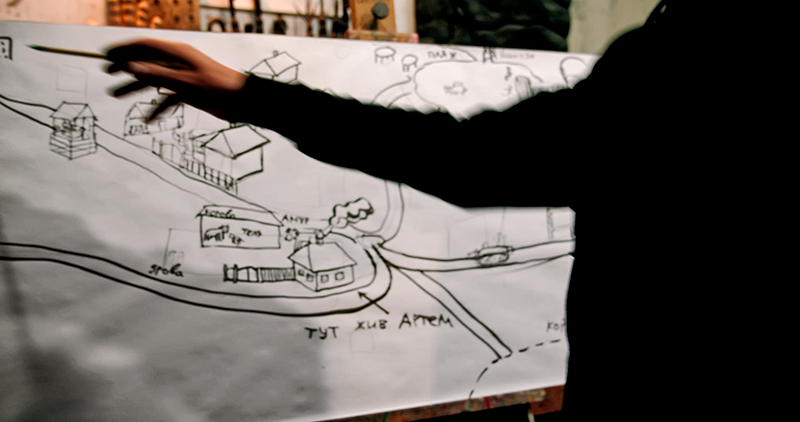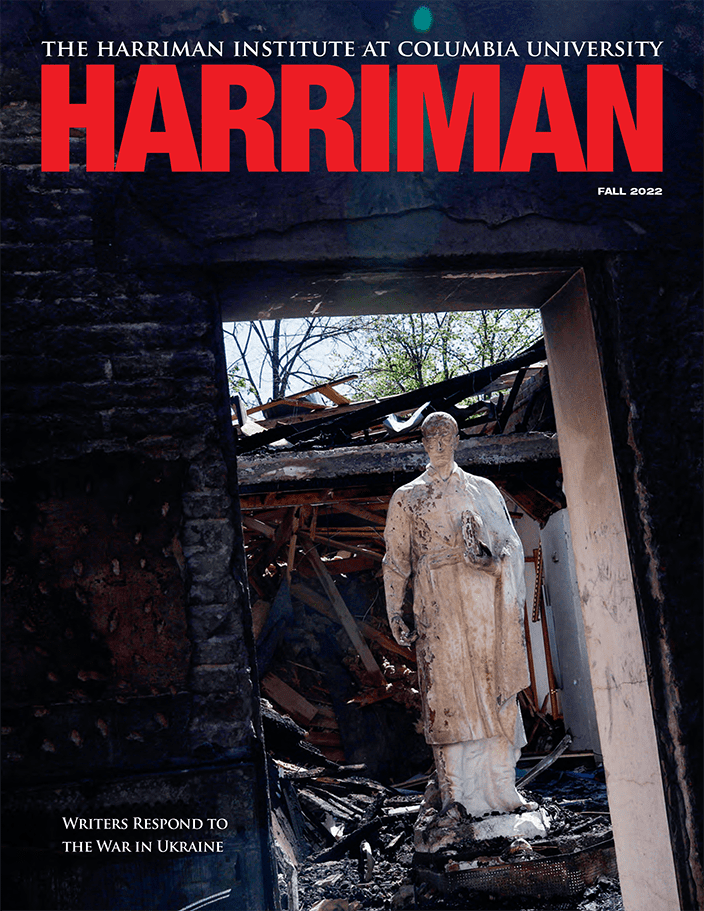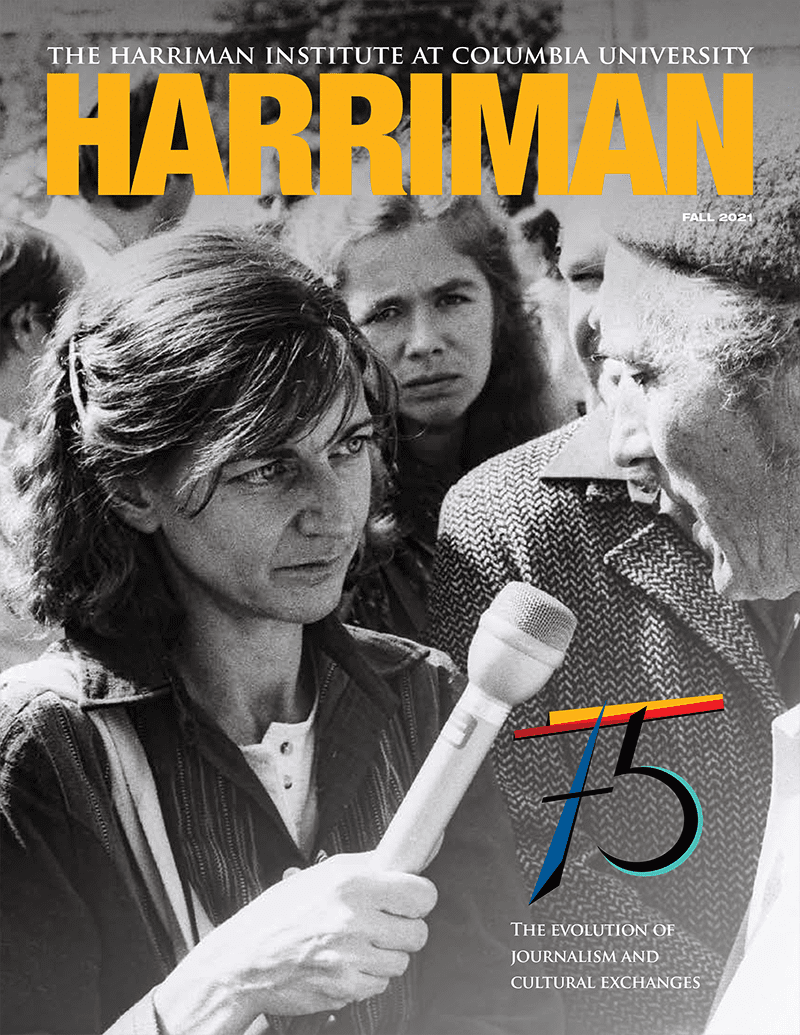A filmmaker’s project may one day help prosecutors hold Russian officials accountable for deporting Ukrainian children.
Ukrainian filmmaker Tetiana Khodakivska was in New York City when Russia launched its full-scale invasion of her homeland in February 2022. On the phone constantly with her mother in Kyiv, and with friends around the world, she watched videos on Zoom of rocket attacks, raised money for medical supplies, and helped Ukrainians find evacuation routes for their children. At night she offered long-distance editing help to friends who were filming on the ground as Russian missiles slammed into their cities.
As an expatriate, dividing her time for several years between New York and Kyiv, Khodakivska felt tormented by Ukraine’s suddenly precarious future. She was part of Babylon 13, a collective of journalists, filmmakers, and others who united to use their skills documenting Ukraine’s political revolution in 2013 and then the conflict that began the following year, when Russian-backed separatists occupied parts of eastern Ukraine. Now, that conflict had escalated dramatically, and as a filmmaker, Khodakivska wondered whether art could still serve a purpose amidst all the horror unfolding in Ukraine. “If all the art couldn’t prevent what is happening now, why do we even need it?” she recalled thinking at the time.

Children who managed to return to Ukraine after deportation to Russia or Russian-held territories worked with filmmaker Tetiana Khodakivska and Ukrainian artists in 2023 to depict their experiences. Still image from The Blue Sweater with a Yellow Hole, a film-in-progress, courtesy of Tetiana Khodakivska, cinematography by Denys Melnyk.
There were existential questions, too. “We didn’t know if the art would survive, if the artists would survive, if our parents would survive,” she recalled during a 2023 event at the Harriman Institute, Art in Time of War: Celebrating Resilience in Ukrainian Culture.
“The Russian government had orchestrated the relocation of Ukrainian children not for their personal safety, but to ‘reeducate’ them in Russian schools and institutions, to erase their Ukrainian identities, in some cases by having them adopted into Russian families. “
In March 2022, just one month into the war, Khodakivska read that Russia was deporting Ukrainian children from recently occupied territory in Luhansk and Donetsk regions and sending them to institutions in other occupied areas or in Russia itself. More stories followed, some in Ukrainian media, some in western outlets. Khodakivska learned that the deportations were not new—children had been removed from occupied areas before the full-scale invasion— and increasingly, it was clear to her that these were not just a few isolated cases. Soldiers were taking children from orphanages, from schools, and from their homes, where they showed up threatening or bribing families to persuade them to send their children to “recreational camps” in Russia and Russian-occupied Crimea.
Russia’s heavily censored media presented the deportation of Ukrainian children as securing their well-being by moving them away from conflict zones to safety in Russia. Reading that Russian propaganda struck a chord with Khodakivska. “This is when I began to see it as a strategy,” she said. Eventually, multiple researchers and media reports seemed to confirm what she was thinking: that the Russian government had orchestrated the relocation of Ukrainian children not for their personal safety, but to “reeducate” them in Russian schools and institutions, to erase their Ukrainian identities, in some cases by having them adopted into Russian families.
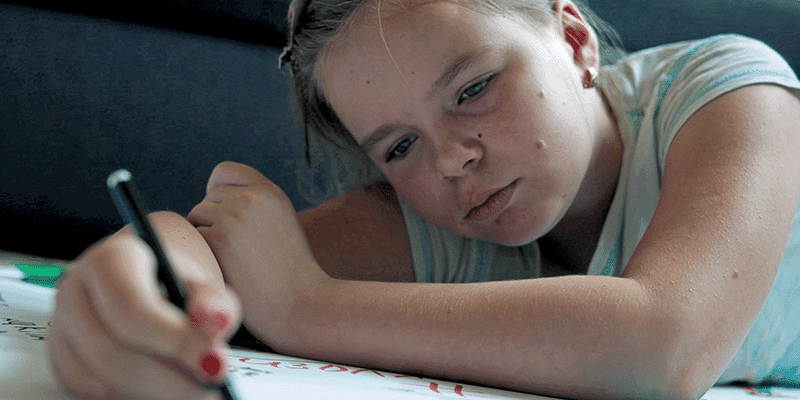
Still image from The Blue Sweater with a Yellow Hole, a film-in-progress, courtesy of Tetiana Khodakivska, cinematography by Denys Melnyk.
As she read more, Khodakivska began making bullet-point lists of events. There was plenty to keep track of. In April 2022, Russian authorities said more than 2,000 children had arrived in Russia. The next month, President Vladimir Putin signed a decree clearing the way for more Russian families to adopt Ukrainian children.
Then the numbers—cited by officials at the United Nations, the U.S. State Department, and some Russian officials—began to escalate. By some estimates, 130,000 or more children had been deported by late 2022. But as Khodakivska began talking about starting her own research project—a documentary film about the deportations—she found that outside of Ukraine, many people were skeptical when she suggested something systematic and sinister was happening; the numbers were just too high, the confirming evidence too scant, some said.
“The Yale lab said it had documented the movement of at least 6,000 Ukrainian children (the actual number was “likely significantly higher,” the report said) to 43 camps and other facilities in Russian-occupied Crimea and mainland Russia.”
That changed in February 2023. “I saw the Yale report,” said Khodakivska, “and that kind of proved what I was thinking.”
That report, from the Yale School of Public Health’s Humanitarian Research Lab, was bluntly titled: “Russia’s Systematic Program for the Re-Education & Adoption of Ukraine’s Children.” The Yale lab said it had documented the movement of at least 6,000 Ukrainian children (the actual number was “likely significantly higher,” the report said) to 43 camps and other facilities in Russian-occupied Crimea and mainland Russia. The research lab’s work was based on open-source data—for example, social media posts by Ukrainian children who managed to keep their smartphones; posts by staff at the “summer camps” where the children were taken; and the online tracking of the vehicles that took them there. At most camp facilities, Yale’s report found evidence that activities for the Ukrainian children “included an identified component of Russia-aligned re-education, which at times included military training.”

Still image from The Blue Sweater with a Yellow Hole, a film-in-progress, courtesy of Tetiana Khodakivska, cinematography by Denys Melnyk.
By design, the Yale researchers looked for forensic evidence and did not speak with parents or any of the Ukrainian children who had been able to return home. The stories of some of those children have been told in media reports, but more information was needed to document the scope of Russia’s effort and its long-term implications, including for possible future war crimes prosecutions, said Khodakivska. “Whatever I do, how can I show that it’s credible?” she asked herself as she planned her own research in Ukraine. She decided that to help verify what happened, she needed to gather a multitude of stories for a documentary film, and for a database that academics and others could use for further research. “That’s how we can say what really happened in these places,” she said.
As she continued thinking about a project about the deported children, Khodakivska helped curate a New York exhibition of Ukrainian art. Among the 40 artists whose work was displayed was Alevtina Kakhidze, who had been using her art to tell the story of war in Ukraine since Russian-backed separatists first occupied Kakhidze’s hometown of Zhdanivka in Donetsk Oblast in 2014. The exhibit featured a series of drawings, accompanied by diary-like bursts of narration, where Kakhidze told the story of her mother’s life in occupied Donetsk (her mother died suddenly in 2019 while waiting to cross into Ukraine at a Donetsk checkpoint). The images were “very childlike,” said Khodakivska, but their very simplicity had a powerful impact on those who saw them in New York. Khodakivska, who had wanted to find a way to connect storytelling and contemporary art in her project, decided to reach out to Kakhidze about working with her film crew in Ukraine.
“Khodakivska just knew that art needed to be a part of telling the story of deportation.”
“My first idea is that we will talk with children, and [Kakhidze] will draw images” of what they describe, to be used in an animated film, said Khodakivska. Kakhidze agreed to meet when Khodakivska got to Kyiv. But no specific plan was finalized; Khodakivska just knew that art needed to be a part of telling the story of deportation.
Before heading to Kyiv, Khodakivska created a partnership with Save Ukraine, a local NGO that organizes rescue missions to return deported Ukrainian children (as of late 2023, Save Ukraine said it had made 13 expeditions and brought home 223 children). The group helped the filmmaker develop a travel plan and connect with families and returned children. The Kherson and Kharkiv regions were target destinations: both had experienced frequent child deportations under Russian occupation, and both were areas where Ukraine had subsequently liberated territories, making it possible for Khodakivska and her crew to visit and interview families there. Other partners in planning for the research trip were Terre Des Hommes Germany, an international children’s rights organization, and a local group, Ukrainian NGO Girls; these groups helped with trauma awareness training for the film crew and psychological support to the children and families Khodakivska would interview.
Still unanswered, though, was the question of how drawing would be incorporated into the project. Shortly after Khodakivska’s arrival, she met the local film crew she would work with at a Kyiv coffee shop. The occasional air raid siren wailed as she spelled out her idea of having the artist sit in on the filming of interviews, making drawings of what the children described— a variation on the courtroom sketch work that Kakhidze sometimes did in Ukraine. But when the cinematographer suggested that having Kakhidze in the room drawing pictures could be distracting for the children, that idea was dropped.
It wasn’t until the film crew and a 15-year-old girl—who had been deported and eventually returned to her family—arrived at Kakhidze’s studio just outside Kyiv that a plan finally took shape. It was the first of the art sessions, and Kakhidze began it by unrolling a long sheet of flimsy tracing paper, attaching it (with Khodakivska’s help) to a wall, and asking: “Will this work?” Then, pens in hand, the artist, the girl, and Khodakivska began talking and drawing.
Khodakivska hadn’t planned to be part of the drawing process. “I don’t know how to draw,” she said, but quickly she saw that her collaboration was comforting for the girl, and later for the other children she interviewed. “They like it. They want to share … It creates an intimate atmosphere,” she said.
“Sometimes they would cry and our sound recorder would start crying,” she said, noting that the team’s display of grief helped parents understand crying was okay.”
With that, the project was underway. Each child was interviewed first by the film crew, then asked if they would like to participate in an art session as well. Nearly a third of the 40 children Khodakivska interviewed returned on a later day to draw, and the filmmaker plans to return to Ukraine to conduct more interviews and art sessions with others. When the team moved on from Kyiv to small villages in the Kherson and Kharkiv regions, areas where fighting was never very far away, they found buildings with secure basements so the art sessions could go on, often for several hours, without being interrupted for a dash to a bomb shelter. And with Kakhidze’s help, they found local artists to collaborate with: artists who had lived through the Russian occupation, which helped them bond with the children.
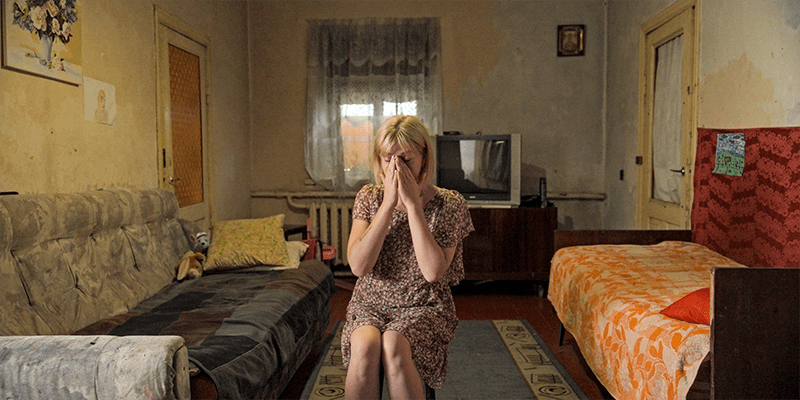
A mother cries while remembering the six months when she did not see her son. Image courtesy of Tetiana Khodakivska and Denys Melnyk.
Creating such emotional connections was key in talking with both children and their parents, said Khodakivska. “Sometimes they would cry and our sound recorder would start crying,” she said, noting that the team’s display of grief helped parents understand crying was okay.
In some interviews, a child would switch gears abruptly from dark memories. “They would say something absolutely emotional like, ‘I lost a house,’” said Khodakivska, and then immediately redirect the conversation—taking out a phone, for example, to show a photo of the family dog.
In such cases, the drawing sessions that followed the interviews often made it easier for a child to recount what happened to them, in part because of the freedom they had to move about the room and draw instead of sitting in front of a camera. They worked on paper, mounted on an easel or stretched across a table or floor, while Khodakivska and the artist stayed close, starting each session with the same set of questions (what did your home look like before the war, for instance) and talking them through their stories as they drew.
“Most often, all three of us had markers or pens,” said Khodakivska. The process might begin with the artist drawing what the child described, but usually the children joined in with their own drawing, coloring, or writing—much like the drawing-diary format Kakhidze had used to tell her mother’s story. The drawings have bold, black strokes that outline people, buildings, and rooms. Details such as facial features are spare, and so are colors. But the stories are clear.
“The lone window is covered with what appears to be barbed wire. This was the ‘isolation room,’ a form of punishment described by several children.”
One girl’s mostly black-and-white drawing has a stark spot of color near the top: a single tree, its green canopy standing in contrast to the image just to the right of it, where a stick figure heads down a steep staircase into a cob webbed basement with a bedstead that has no mattress or covers. The lone window is covered with what appears to be barbed wire. This was the “isolation room,” a form of punishment described by several children Khodakivska interviewed; children could be sent there for infractions such as saying “Slava Ukraini” or refusing to sing the Russian anthem. Variations of isolation rooms are seen in other drawings; the collective credibility of the testimonies about this form of punishment is reinforced with each additional description, said Khodakivska.
Among the most disturbing images from the art sessions is a six-headed green dragon bearing the letter Z to signal its support of Russia’s 2022 invasion of Ukraine. The dragon appears in a long artistic narrative created collaboratively by a local artist, Iryna Potapenko, Khodakivska, and Artem, a 14-year-old boy from Kherson. After occupying Artem’s town, the new Russian authorities ordered children to attend schools under Russian control. Some, like Artem, stayed home, studying online with Ukrainian schools when they could get an Internet connection. Eventually soldiers came to Artem’s home; the metaphorical dragon represents his memory of their visit. Each of its six long necks are topped by a soldier’s helmeted head spitting fire at the tiny figure of a child below. All around them are Russian phrases, written by Artem, of the dragon heads shouting:
“We came to save you from Ukrainian Nazis!”
“Why aren’t you in Russian school?”
“We will take parental rights from your mother.”
The presentation of these phrases, in red, capital letters, seems to emphasize the menace lingering in Artem’s memory.
“There are many, many cases when [Russian] Army people would come to these parents or to grandparents with guns, saying, ‘If you do not give your child to Russian school, we will take him or her out of here, and you will lose your parental rights,’ ” said Khodakivska.
In other cases, Russian soldiers “would literally come to a school and just take all the children, put them in a car, and just drive them away, without the parents knowing,” she said. Children were also taken from orphanages or separated from their families in “filtration camps,” set up to interrogate Ukrainians; once in Russia or Russian-controlled territory, some have been put up for adoption or foster care. Russian soldiers have also played on familial guilt, telling parents in occupied areas that it’s dangerous for their children to remain there “because Ukrainians are coming and there would be street fighting. So let us take your kids for two weeks of camp. They will be safe,” said Khodakivska.
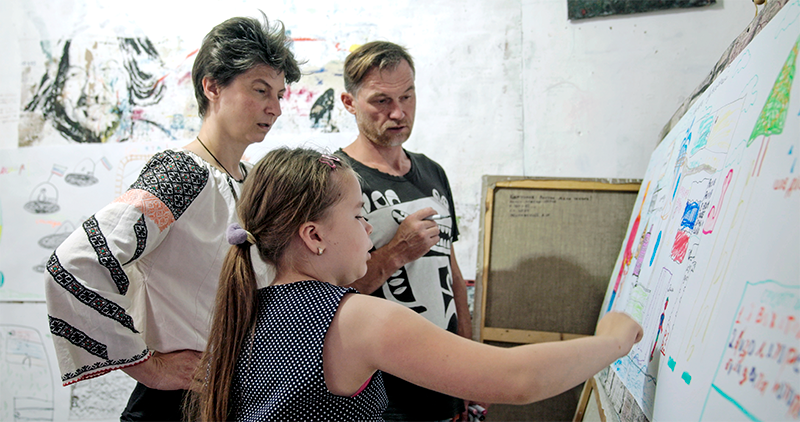
When Khodakivska returned to her Manhattan home in late summer 2023, she had 20 drawings from the art sessions and more than 60 filmed interviews: 40 with children, the rest with family members. In addition to the documentary, she plans to put all these interviews—and more she hopes to conduct in 2024—into a database that researchers and legal experts can search by subject (“physical abuse,” for example, or “punishment cell”).
In recording these stories Khodakivska and the partners in her project have joined a determined cadre of academics, human rights activists, and journalists whose work may one day help prosecutors hold Russian officials accountable for war crimes.
Just weeks after the February 2023 Yale report was released, the International Criminal Court in the Hague sent an early prosecutorial warning, issuing arrest warrants for Russian President Vladimir Putin and for Maria Lvova-Belova, who serves as Russia’s children’s rights commissioner. The ICC said Putin and Lvova-Belova were “allegedly responsible for the war crime of unlawful deporting of population (children) and that of unlawful transfer of population (children) from occupied areas of Ukraine to the Russian Federation.” Though estimates vary widely and remain unconfirmed, researchers at the Yale lab and elsewhere believe at least 130,000 Ukrainian children may have been unlawfully transferred to Russia or Russian-held Ukrainian territory. Legal analyses by the Yale lab and others say the deportations could violate several international protocols, including the Geneva Conventions and the Convention on the Rights of the Child.
The social media and other online sources researched by the Yale lab provide forensic evidence, while interviews on the ground—conducted by Khodakivska and various journalists, including those from Ukrainian media—provide vital witness testimony. Both can be valuable for future prosecutions, said Nathaniel Raymond, executive director of Yale’s Humanitarian Research Lab.
“Camp officials confronted Taisia for wearing a sweater with a yellow and blue design because it represented the colors of the Ukrainian flag. They ordered her to cut the design out with scissors.”
“Very rarely do you try a case with the bullet and not the body, right? You always want both,” said Raymond. In legal terms, he said, the testimony of children targeted by Russia “is prima facie probative. [Khodakivska] has images of purported children, and that right there is gold.”
The interviews will also be part of Khodakivska’s documentary, The Blue Sweater with a Yellow Hole, set for release in 2025. The film is titled after a painful story told in a drawing made with 14-year-old Taisia, who was sent to a Russian “summer camp” in Crimea from her home near Kherson. Upon her arrival, camp officials confronted Taisia for wearing a sweater with a yellow and blue design because it represented the colors of the Ukrainian flag. They ordered her to cut the design out with scissors. She refused and the officials cut it out themselves. The drawing narrates this incident step by step, showing a giant pair of scissors in the official’s hand and Taisia crying blue tears after the sweater is cut, the square with the Ukrainian colors lying at her feet on the floor.
Khodakivska hopes that drawings like Taisia’s can help bring the deportation story to larger audiences. And that this can serve as an early warning for other countries facing similar challenges. “It’s not just about me being Ukrainian and attempting to shed light on what is happening to these children,” she said. Misinformation, propaganda, and manipulation of information “are all a universal concern,” especially in the new age of artificial intelligence, she said. “We all need to work together to understand how to resist it to prevent other wars and war crimes.” ◆

